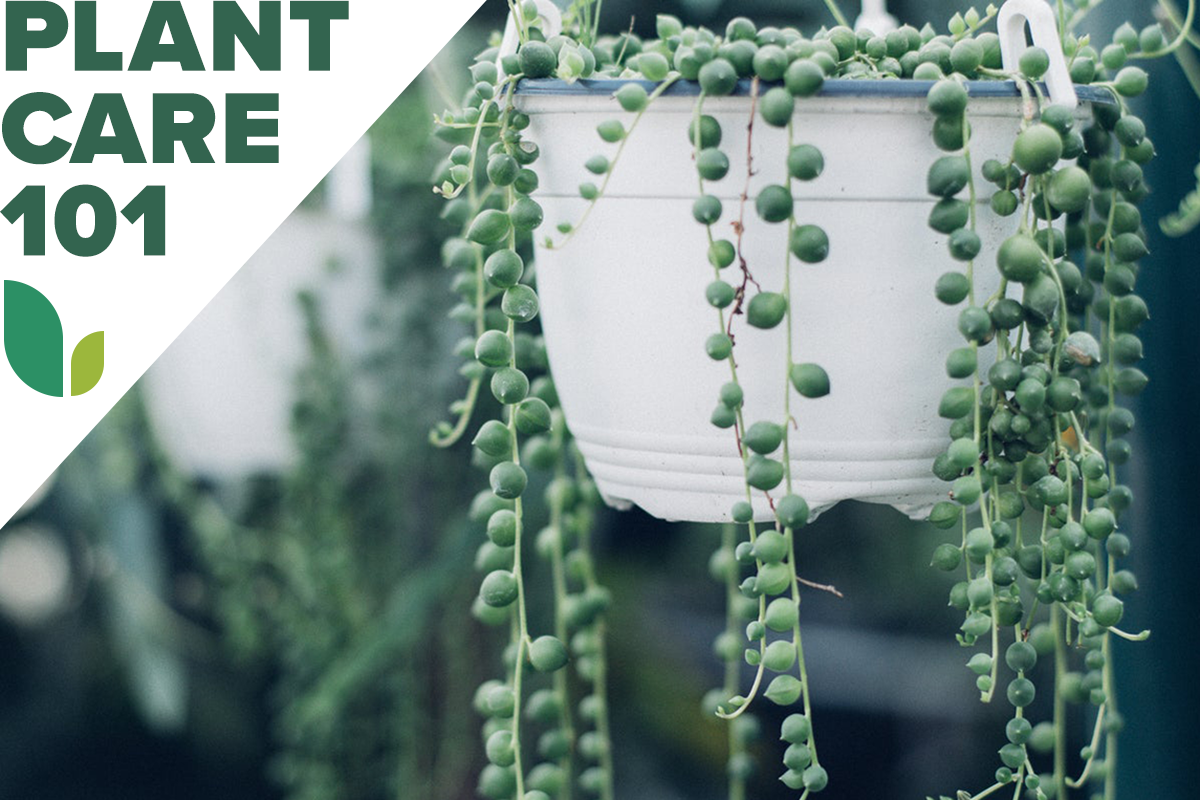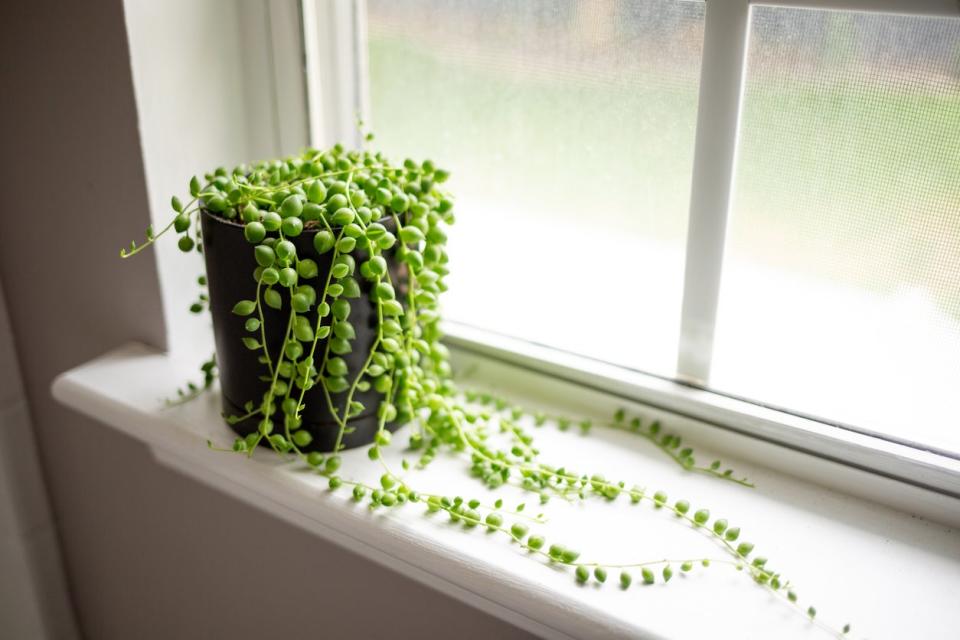String of Pearls Care

True to its genus name, Curio, the string of pearls plant is novel and bizarre indeed, with draping foliage resembling strands of beads. While curious, string of pearls succulents aren’t hard to find, so gardeners on any budget can grow them in abundance.
Best of all, string of pearls care is easy and beginner-friendly, so you’ll need to watch out for little else beyond the usual succulent pitfalls of overwatering and seasonal temperature needs.
String of Pearls Care at a Glance
Common Name: String of pearls, string of beads
Scientific Name: Curio rowleyanus (formerly Senecio rowleyanus, Kleinia rowleyana)
Soil: Cactus potting mix
Light: Partial sun
Water: Low
Food: Balanced plant food
Temperature and Humidity: Warm; cool in winter
Propagation: Stem cuttings
Safety: Toxic
String of Pearls Characteristics

Photo: Leonora Enking from West Sussex, England, CC BY-SA 2.0, via Wikimedia Commons
According to the University of Wisconsin-Madison Extension, string of pearls is a ground cover native to South Africa, capable of taking root wherever its nodes touch the soil. The string of pearls succulent does well in USDA hardiness zones 9 through 12 and is typically grown in pots or hanging baskets, from which its strands can dangle 2 to 3 feet.
Formerly known as Senecio rowleyanus or Kleinia rowleyana, string of pearls is often sold under its newer name, Curio rowleyanus. Its small, spherical green leaves have pointed tips and a darker stripe on the side of each “pearl.” Each of these orbs is actually a semitransparent, light-capturing window for photosynthesis. If kept cool in winter, string of pearls can produce puffy, 1/2-inch white flowers with protruding red stamens in summer.
Types of String of Pearls

Photo: Etsy.com
This plant has undergone several name, or taxonomy, changes. When shopping for a string of pearls plant, look for Curio, Senecio, or Kleinia in the name.
Curio rowleyanus f. variegatus: The variegated string of pearls plant flaunts foliage splashed with cream, pink, and green shades.
Senecio ‘Hippogriff’ (Curio x peregrinus): Commonly known as string of dolphins, this hybrid dangles dolphin-shaped beads instead of pearl-shaped ones.
Soil for String of Pearls Plants
As with other succulents and low-water plants, string of pearls soil needs to drain well to combat root rot. Select cactus or succulent potting mix, or use 2 parts standard potting mix combined with 1 part of either coarse builder’s sand or perlite.
When choosing a pot for a string of pearls plant, opt for a shallow terra-cotta container with drainage holes. The best pots for succulents allow excess moisture to escape through those holes as well as their porous sides. Because they hold in too much water, avoid using deep plastic hanging baskets that lack drainage holes.
The Right Light

Photo: istockphoto.com
Sunlight is another key consideration for string of pearls plant care, as this succulent doesn’t sit out in full sun all day long in its natural habitat. Although it can tolerate full sun, 3 to 4 hours of partial sun per day works best for string of pearls.
For optimal string of pearls light conditions indoors, position the plant on an east- or west-facing windowsill, where it will receive sun either all morning or all afternoon. The plant can also thrive in bright, indirect light, as long as that light is bright enough (more than 200 foot-candles).
Watering String of Pearls

Photo: Amazon.com
Overwatering, which causes root rot, is a top killer of succulents. Curio rowleyanus is no different, so knowing how often to water string of pearls is of the utmost importance to avoid soggy soil. Its beadlike foliage actually stores moisture, allowing it to survive on less water than one might assume.
From spring through autumn, don’t water your string of pearls until at least the top 1/2 to 1 inch of soil is dry. Try to avoid getting droplets on the stems or leaves when you water it. During winter, cut back even further by watering the plant only about once per month.
If string of pearls foliage begins to shrivel when the top layer of soil is dry, slightly increase the amount of water the plant receives. If the beads are wilting when the soil is wet, however, it could mean that the plant’s roots have rotted from overwatering.
Fertilizing String of Pearls Plants
Fertilizer is actually optional for growing string of pearls since the plant naturally thrives on nutritionally poor soil. If you want to speed up your succulent’s growth, however, feed it a balanced plant food mixed at half strength every 2 weeks from spring through autumn. Refrain from feeding it during winter.
Setting the Temperature and Humidity
During their growing season, string of pearls plants prefer warm temperatures between 70 and 80 degrees Fahrenheit. In winter, they should be kept at around 55 to 60 degrees Fahrenheit. One way to help your plant maintain that cooler winter temperature range is to place it in a bright and chilly—but not frosty— attached garage, breezeway, sunporch, or greenhouse.
String of pearls care generally doesn’t involve humidity enhancement, as the plant doesn’t require moist air. Misting is unnecessary and may cause rot.
Pruning String of Pearls
Pruning string of pearls is characteristically easy: Simply locate any overgrown, dead, or yellowing strands on the plant, and then use clean, sharp pruning shears or scissors to make a diagonal cut just above a set of leaves on the strand.
It’s best to prune string of pearls during its active growth period, typically in spring or summer. Doing so helps maintain the plant's shape and promotes healthier growth in the long run.
Propagating String of Pearls

Photo: SucculentCreationz via Etsy.com
If you’re wondering how to propagate string of pearls, there are actually a couple of ways to go about it. Because this species can root wherever its nodes touch the soil, one option is to cut pieces from a rooted plant to easily propagate a new succulent. As an alternative, you can also root strands while they are still attached to the mother plant by following these steps:
Find a bare spot in the original pot or position a new pot nearby and lay the ends of a few strands across the surface of the soil.
Push the ends of the strands lightly down into the soil, pinning them down with U-shaped hairpins or landscape staples, if necessary.
Keep the soil damp but not soggy by misting it.
After they root at the nodes, which should take a few weeks, cut the rooted strands free from the mother plant.
Safety Considerations
String of pearls is mildly toxic and can cause symptoms like nausea and diarrhea in both people and animals if it is ingested. The dangling foliage may be enticing to pets or children, who may pull them and cause the entire pot to fall, potentially leading to injury. To avoid either scenario, position hanging string of pearls containers up high.
The plant’s sap can cause skin irritation in some individuals, especially those with sensitive skin. As a precaution, consider wearing rubber or gardening gloves while pruning or repotting string of pearls.
Potential Pests and Diseases
Aphids or mealybugs may appear on string of pearls foliage, but they can safely be eliminated by dabbing them with a cotton swab dipped in rubbing alcohol.
Root rot, the chief enemy of string of pearls, is often indicated by shriveling or yellowing foliage and stems. If your plant begins to rot, remove any dead and dying growth and give what remains more light and air—and less water. If the plant is growing in an overly large plastic pot or one with no drainage holes, try moving it to a shallower terra-cotta pot filled with fresh cactus potting mix.
FAQs About String of Pearls Care

Photo: istockphoto.com
If you still need a few quick pointers on how to care for string of pearls, check out the questions and answers below.
Q: How do you make string of pearls fuller?
Pruning string of pearls periodically (targeting yellowed, dying, or overgrown strands) will help maintain a bushier, fuller shape.
Q: How do you repot string of pearls?
Gently remove the string of pearls plant from its existing pot, carefully shake off any excess soil from the root ball, and move it to a slightly larger pot with fresh, well-draining soil. Fully cover the root ball and lightly water the plant.
Q: How fast does string of pearls grow?
String of pearls is a fast-growing ground cover that can gain up to 15 inches in length per growing season.
Q: Why is my string of pearls dying?
The most common killer of string of pearls is root rot, which is caused by overwatering. Wait to water the plant until the top 1/2 to 1 inch of soil dries, and consider using a moisture meter to help gauge when your succulent needs water.
Looking for more challenging houseplants to test your green thumb? Check out our guides on caring for avocado, bird of paradise, and croton.

